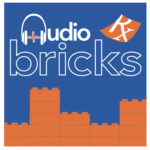The Rx Bricks Podcast
Your High-Yield Med Content on the Go
Build your foundation of medical knowledge and close your learning gaps brick by brick. We’re turning our high-yield multimedia learning library, Rx Bricks, into an immersive audio experience—so you can turn downtime into high-yield learning time.
Get the upper edge and listen for free wherever you get your podcasts.
Latest Episodes

Today’s Audio Brick is based on an upcoming Brick 2.0. If you’re looking for supplemental information from Bricks 1.0, read up on our 1.0 Structure and Function of the Pituitary Gland brick. If you enjoyed this episode, we’d love for you to leave a review on Apple Podcasts. It helps with our visibility, and the more…
Listen »
Today’s Audio Brick is based on an upcoming Brick 2.0. If you’re looking for supplemental information from Bricks 1.0, read up on our 1.0 Structure and Function of the Pituitary Gland brick. If you enjoyed this episode, we’d love for you to leave a review on Apple Podcasts. It helps with our visibility, and the more…
Listen »
Today’s Audio Brick is based on an upcoming Brick 2.0. If you’re looking for supplemental information from Bricks 1.0, read up on our 1.0 Cardiac Conduction System brick. If you enjoyed this episode, we’d love for you to leave a review on Apple Podcasts. It helps with our visibility, and the more med students (or future…
Listen »
Today’s Audio Brick is based on an upcoming Brick 2.0. If you’re looking for supplemental information from Bricks 1.0, read up on our Calcium and Phosphate Homeostasis Brick. If you enjoyed this episode, we’d love for you to leave a review on Apple Podcasts. It helps with our visibility, and the more med students (or future…
Listen »
Today’s Audio Brick focuses on valvular disease, and is based on a new brick that will be arriving soon. If you’re looking for supplemental information from Rx Bricks, read up on our Calcium and Phosphate Homeostasis Brick. As a listener of the podcast, you can take 50% off a subscription with code RXPOD. If you…
Listen »
Today’s Audio Brick is based on an upcoming Brick 2.0. If you’re looking for supplemental information from Bricks 1.0, read up on our Calcium and Phosphate Homeostasis Brick. As a listener of the podcast, you can take 50% off a subscription with code RXPOD. If you enjoyed this episode, we’d love for you to leave…
Listen »
Aortic stenosis (AS) is a condition in which there is a narrow left ventricular outflow tract caused by failure of the aortic valve to open up completely. The heart has to work harder to pump blood through this tight opening to deliver blood to the rest of the body. The aortic valve is positioned between the…
Listen »
Today’s Audio Brick is based on the upcoming Brick 2.0: Renal Calcium and Phosphate Regulation. If you’re looking for supplemental information from Bricks 1.0, read up on our Calcium and Phosphate Homeostasis Brick. As a listener of the podcast, you can take 50% off a subscription with code RXPOD. If you enjoyed this episode, we’d…
Listen »
As you’ve probably gleaned by now, this discussion is all about male reproductive anatomy (including the testicles). We’ll stick mostly to structures here because male reproductive function and details of the male sexual response are covered elsewhere. Let’s start with the basic setup. After listening to this Audio Brick, you should be able to: Identify…
Listen »
Today’s Audio Brick is based on the upcoming Brick 2.0: Contractility, Preload, and Afterload. If you’re looking for supplemental information from Bricks 1.0, read up on our Cardiac Muscle Contractility Brick. As a listener of the podcast, you can take 50% off a subscription with code RXPOD. If you enjoyed this episode, we’d love for…
Listen »